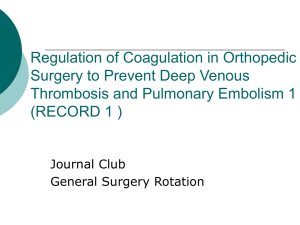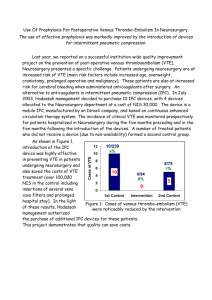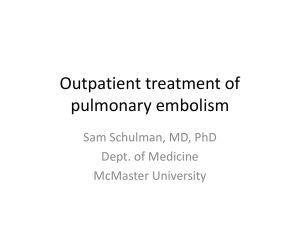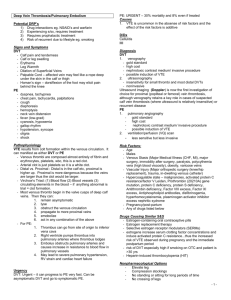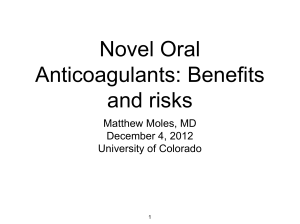September 2015 REBELCast Show Notes - REBEL EM
advertisement
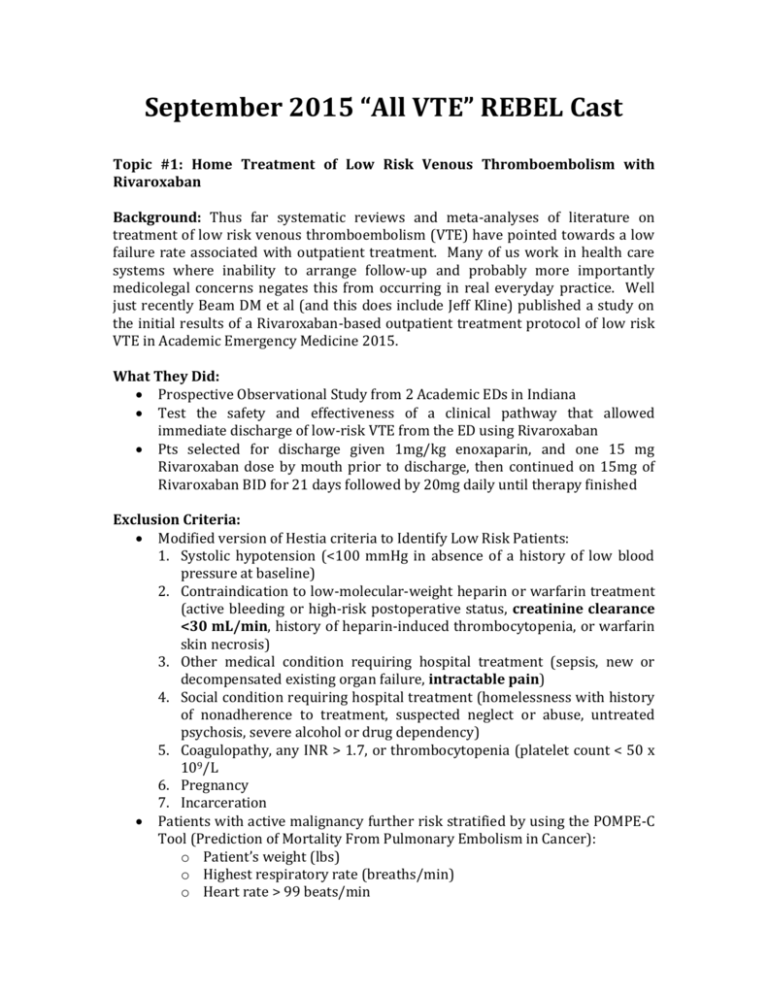
September 2015 “All VTE” REBEL Cast Topic #1: Home Treatment of Low Risk Venous Thromboembolism with Rivaroxaban Background: Thus far systematic reviews and meta-analyses of literature on treatment of low risk venous thromboembolism (VTE) have pointed towards a low failure rate associated with outpatient treatment. Many of us work in health care systems where inability to arrange follow-up and probably more importantly medicolegal concerns negates this from occurring in real everyday practice. Well just recently Beam DM et al (and this does include Jeff Kline) published a study on the initial results of a Rivaroxaban-based outpatient treatment protocol of low risk VTE in Academic Emergency Medicine 2015. What They Did: Prospective Observational Study from 2 Academic EDs in Indiana Test the safety and effectiveness of a clinical pathway that allowed immediate discharge of low-risk VTE from the ED using Rivaroxaban Pts selected for discharge given 1mg/kg enoxaparin, and one 15 mg Rivaroxaban dose by mouth prior to discharge, then continued on 15mg of Rivaroxaban BID for 21 days followed by 20mg daily until therapy finished Exclusion Criteria: Modified version of Hestia criteria to Identify Low Risk Patients: 1. Systolic hypotension (<100 mmHg in absence of a history of low blood pressure at baseline) 2. Contraindication to low-molecular-weight heparin or warfarin treatment (active bleeding or high-risk postoperative status, creatinine clearance <30 mL/min, history of heparin-induced thrombocytopenia, or warfarin skin necrosis) 3. Other medical condition requiring hospital treatment (sepsis, new or decompensated existing organ failure, intractable pain) 4. Social condition requiring hospital treatment (homelessness with history of nonadherence to treatment, suspected neglect or abuse, untreated psychosis, severe alcohol or drug dependency) 5. Coagulopathy, any INR > 1.7, or thrombocytopenia (platelet count < 50 x 109/L 6. Pregnancy 7. Incarceration Patients with active malignancy further risk stratified by using the POMPE-C Tool (Prediction of Mortality From Pulmonary Embolism in Cancer): o Patient’s weight (lbs) o Highest respiratory rate (breaths/min) o Heart rate > 99 beats/min o o o o Altered mental status Respiratory distress Do not resuscitate status Unilateral limb swelling Outcomes: Recurrence of VTE after treatment Rate of bleeding during treatment Results: Total of 106 patients o 71 (67%) with DVT o 30 (28%) with PE o 5 (5%) with both DVT and PE This protocol captured 35/131 (27%) patients with PE and 71/140 (51%) with DVT for early discharge Among patients with isolated DVT approximately half were proximal and most (28/37 or 76%) of PEs were segmental or larger 50% of patients were self-pay in this study VTE Recurrence: o 0% (95% CI 0 to 3.4%) developed recurrent or new VTE while on therapy o 2.8% (95% CI 0.6% to 8%) had VTE recurrence after completion of therapy (all recurrent DVTs) 89/106 (82%) of patients had at least one clinic follow-up appointment in person 4/106 (4%) of patients lost to follow up Bleeding Events: o ZERO major bleeding events o 4 total patients (3 menorrhagia; 1 jaw swelling after dental extraction) had to hold one day of therapy without any other interventions Strengths: At every follow up appointment or phone contact compliance was checked by: o Asking where the medicine was filled o Asking if any doses missed o Asking what time of day pills were taken o A formal pill count verification For patients who could not be contacted by phone the Indiana Network for Patient Care and Social Security Death Index were checked for any bad outcomes Only 4 patients or 4% of study population lost to follow up Limitations: Follow up of patients was very robust (i.e. at 2 days after discharge phone call follow up, follow up visits at 2 to 5 weeks, and 3 to 6 months after diagnosis). Now this may sound like a strength of the study, but I work at a county ED. I can’t get this kind of follow up for my patients. I am lucky if I can get them a follow up appointment at 1 month. My point being is this aspect of the protocol may reduce the generalizability for physicians in the community. Biased, low risk patient population, which was intended by design using the modified Hestia Score and POMPE-C scores to select out higher risk patients. This led to very high discharge rates from the ED (27% with PE and 51% with DVT) 4 patients lost to follow up were deemed negative for recurrent VTE, but if any of them did have recurrent VTE then the 2.8% recurrence rate may be an underestimate of recurrence. Discussion: A pooled analysis of the EINSTEIN DVT and PE studies found a rate of 2.1% of VTE recurrence and a 9.4% rate of clinically relevant major and nonmajor bleeding within 200 days while taking Rivaroxaban. Single dose enoxaparin was used in this study for two reasons: 1. 73% of patients in EINSTEIN trials received heparin prior to receiving Rivaroxaban 2. Rivaroxaban had to be ordered from pharmacy, while enoxaparin was stocked in ED Low-income, uninsured patients were offered a national foundation to provide Rivaroxaban free of charge or at a deeply discounted rate for up to 1 year (www.jjpaf.org) Duration of anticoagulation was individualized to each patient using a combination of published criteria, evidence, clinician judgment, and shared decision-making. o Factors Causing Recommendation of Longer Duration: Prior VTE history, high-risk clot location (i.e. proximal, recurrent PE), male sex, obesity, postthrombotic symptoms, and D-dimer concentration on therapy) o Factors Causing Recommendation of Shorter Duration: Risks for bleeding (i.e. alcoholic with fall risk), distal DVT or PE< and provoked VTE All patients with a proximal DVT or any PE and no contraindications were instructed to take 81mg of aspirin daily for life after completing treatment (Shown to decrease recurrence rates by half when compared with no aspirin treatment) Definition of Significant Bleeding Event: >2g/dL acute drop in hemoglobin or >2U blood transfusion, bleeding in critical area, or bleeding that contributed to death, or clinical relevant non-major bleeding (bleeding that required patients to make an unscheduled visit to any health care provider, permanently discontinue anticoagulation, or significantly alter activities of daily living for more than a few days) The 3 patients with recurrent VTE were all compliant with medications and completed courses o Patient 1 -> Recurrent same side proximal DVT 2 months after completion o Patient 2 -> Recurrent same side proximal DVT 8 months after completion o Patient 3 -> Recurrent same side below the knee DVT 3 months after completion Author Conclusion: Patients who are low risk and diagnosed with VTE can be immediately discharged from the ED while treated with Rivaroxaban with a low rate of VTE recurrence and bleeding Clinical Take Home Point: This study provides us with more evidence that in a appropriately selected low risk patient population with VTE, and close follow up, outpatient anticoagulation with Rivaroxaban is feasible with very low rate of recurrence of VTE and risk of bleeding while on therapy. References: Beam DM et al. Immediate Discharge and Home Treatment with Rivaroxaban of Low-risk Venous Thromboembolism Diagnosed in Two U.S. emergency Departments: A One-year Preplanned Analysis. Acad Emerg Med 2015; 22(7): 788 – 95. PMID: 26113241 For More Thoughts on This Topic Checkout: Ken Milne at The SGEM: SGEM #126 – Take me to the Rivaroxaban – Outpatient Treatment of VTE Topic #2: RV Dilation on Bedside Echo Performed by ED Physicians Background: Lets face it, diagnosing someone with a pulmonary embolism is a serious diagnosis, that carries a lot of stress both for the physician and the patient. We know that the range of mortality is anywhere from 2.5% up to 33% depending on what source you read and typically the treatment is anticoagulation for 3 – 6 months, but if that is not enough to stress you out, what about missing a submassive PE? And even if you do diagnose it, does this patient now get half dose lytics? If you are out in the community and not ultrasound trained, how comfortable do you feel putting the echo on the patients chest from the bedside and diagnosing right ventricular dysfunction? To be more specific right ventricular dilatation, right ventricular hypokinesis, paradoxical septal wall motion, McConnell’s sign (i.e. right ventricular wall hypokinesis with apical sparing), or maybe even tricuspid regurgitation? Well what is known is that patients with right ventricular dysfunction on echo, have a worse prognosis in the setting of PE, but that worsened prognosis can be decreased with acute treatment. So what if all you had to do was recognize right ventricular dilatation on echo? Would that be easy enough? It certainly could help expedite decisions about treatment and disposition ultimately reducing morbidity and mortality in patients. And I am here to tell you, that is exactly what the authors of this study did: Determine the diagnostic performance of RV dilatation identified by POCUS, by EM physicians in patients with suspected or confirmed PEs. What They Did: Prospective, Observational study of a convenience sample of ED patients with suspected or confirmed PE Single Center study at Boston Medical Center (A large urban academic ED) Outcomes: Primary Outcomes: Sensitivity, Specificity, PPV, NPV, +LR, and –LR of RV dilatation on bedside echo in patients with PE Secondary Outcomes: Presence of advanced signs of RV dysfunction on echo (RV hypokinesis, paradoxical septal motion, and McConnell’s Sign) Results: 146 patients were enrolled in the study and included in the final analysis PE prevalence was 21% (30/146) 29/146 had a normal right ventricular: left ventricular ratio on echo 17/146 had an increased right ventricular: left ventricular ratio on echo RV dilatation was identified in 15/30 patients with PE RV dilatation was absent in 114/116 patients w/o PE o The 2 patients with RV dilatation w/o PE both had COPD RV dilatation for diagnosis of PE o Sensitivity 50 (95% CI 32 – 68%) o Specificity of 98% (95% CI 95 – 100%) o PPV of 88% (95% CI 66 – 100%) o NPV of 88% (95% CI 66 – 100%) o +LR 29 (95% CI 6.1 – 64%) o -LR 0.52 (95% CI 0.4 – 0.7%) RV hypokinesis 11 patients with 10 having dx of PE (Sensitivity 33%; Specificity 99%) McConnell’s Sign 6/6 patients with PE (Sensitivity 20%; Specificity 100%) Paradoxical Septal Motion 8/8 patients (Sensitivity 27%; Specificity 100%) Strengths: Physicians doing the bedside ultrasound were blinded to results of confirmatory studies (i.e. CT Pulmonary Angiogram or Ventilation-Perfusion scan) Limitations: Patients only enrolled Monday – Friday from 8am – 11pm which can always lead to selection bias Single Site study at an academic ED with active US training which may make generalizability of all these results more difficult in the community The study was not powered for secondary outcomes, which means a larger study would need to be performed in order to confirm these findings This was a younger patient population (Average age of 49 years) which means many of the patients would not have COPD, which could falsely elevate the specificity of the RV dilation on echo in the setting of PE Discussion: 4 EM Physicians were the ones performing the ultrasounds. o 1 US fellowship trained faculty o 3 (2 EM residents, 1 US fellow) required at least a 1 month ultrasound rotation during residency also had to complete a minimum of 25 cardiac ultrasounds, plus 5 additional hands-on and image review sessions with the principal investigator (10 hours) The 3 views of ultrasound that were used were the parasternal long axis, parasternal short axis, and apical 4-chamber views and a normal RV: LV ratio was defined as 0.6:1.0 Patients with signs of RV dilatation did correlate to more proximal emboli, meaning a larger clot burden and more potential for cardiovascular collapse The benefits of starting anticoagulation before definitive diagnosis of PE have to be weighed against the risk of bleeding. In this paper bleeding rates were estimated to be between roughly 2 – 3.5% and 25% of these bleeding events being fatal Author Conclusion: RV Dilatation and RV dysfunction identified by ED physician performed echocardiography are highly specific for PE, but with poor sensitivity. Bedside echocardiography is a useful tool that can be incorporated into the algorithm of patients with a moderate to high pretest probability of PE. Clinical Take Home Point: With appropriate ultrasound training, ED physicians can perform POCUS echocardiography with visualization of RV dilatation, in patients without other causes/explanations of RV strain. And this finding would be a valuable tool that should increase clinical suspicion for PE. References: 1. Dresden S et al. Right Ventricular Dilatation on Bedside Echocardiography Performed by Emergency Physicians Aids in the Diagnosis of Pulmonary Embolism. Ann Emerg Med 2014; 63: 16 – 24. PMID: 24075286
